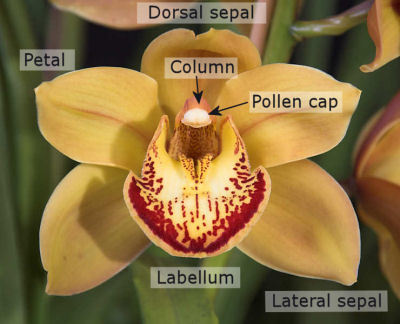Plants use their flowers to attract attention of their pollinators, which include the likes of birds, bees, bats etc. But mind it, we figure nowhere in their scheme of things and are rather a nuisance! We waste a lot of time and energy of the plants when we pluck off their flowers. Flowers play a very crucial part in the life cycle of angiospermic plants (angiosperms are the flower producing plants). Orchids also belong to this group.
Through evolution orchid flowers (like all other plants) have developed varying shapes, sizes, colours, fragrances etc.; this to facilitate the process of pollination. Orchid flowers are zygomorphic, which means that they have a bilateral symmetry. This, in turn, means that when you cut up an orchid flower vertically in the middle, both portions are identical. Orchids being monocots have floral parts in the group of 3’s. They have three sepals, three petals, three fused anthers (filaments) and ovaries (carpels).
The parts common to most orchid flowers are: the pedicel or stalk which joins the flower with the stem. The colourful part of the flower is the perianth, which constitutes the non-reproductive part of the flower. It is attached to the pedicel. Perianth has two whorls of sepals and petals, which maybe free or fused together to form a tube. The two main functions of the perianth are to protect the reproductive parts, especially at bud stage and to facilitate pollination by attracting the pollinating agents (birds and bees!). Unlike most plants, sometimes the sepals of orchid flowers more colourful than the petals and possess colours other than green.
Depending upon the type of pollinators visiting the flower, the orchid develops particular characteristics. Say for example, bright colour is usually seen in bird pollinated flowers, while white coloured and scented flowers are visited by insects (moths and bees).
Sometimes nectaries are also present either at the base of sepals or petals or the ovaries, to provide further incentives to the insect pollinators.
Orchids have dioecious flowers, i.e. both anthers and ovaries are present inside the perianth. The reproductive parts are fused together in the orchid flower, forming a single structure called the column. The column is also referred to as gynostemium, gyandrium etc.
 Photography credit: Dennis Chuah
Photography credit: Dennis Chuah
The Orchid Flower
Beginnersby Anu Dharmani
Originally published in BellaOnline
Posted by Sys Admin over 7 years ago.Article Blog Article Index
Share on Social Media:
New Topics
- John Urey asked question Blooming Stenglottis Venus “jamboree “ in category General Discussion
- Claudia Young asked question RO system in category General Discussion
- Roberto Lizama asked question Help to identify in category General Discussion
- Tatjana Opekunova asked question Cattleya new roots and Flower buds in category Cattleya Alliance
- Mary Lane asked question Orchid roots .com site? in category General Discussion
New Comments
- Carol Holdren commented on topic "Blooming Stenglottis Venus “jamboree “" by John Urey
- Jeanne Uzar Hudson commented on member plant Lc. Canhamiana var. coerulea 'Cobalt' by Jeanne Uzar Hudson
- Jeanne Uzar Hudson commented on member plant Sns. gemmata by Jeanne Uzar Hudson
- Stefan Neher commented on topic "Orchid roots .com site?" by Mary Lane
- Kevin Barry commented on member plant Bul. Tammie Sue Pernas by Tony Pernas
- Linda Hartman commented on member plant Ctt. Final Blue by Linda Hartman
- Kevin Bergeson commented on member plant Paph. rothschildianum by Kevin Bergeson
- Carol Holdren commented on topic "recently purchased orchid shows unstoppable roots " by David George
- Michael Makio commented on orchid V. Beatrice Makio
- Carol Holdren commented on topic "shorter stem with less vigorous blooms" by katherine mott
- Carol Holdren commented on topic "need info on yellow bird" by Glenda Ratliff
- Carol Holdren commented on topic "Looking to join an orchid club." by Paula Milano
- Jeanne Uzar Hudson commented on topic "Repotting Large Cattleyas" by Jeanne Uzar Hudson
- Jeanne Uzar Hudson commented on member plant Paph. malipoense by Jeanne Uzar Hudson
- William Gorski commented on topic "how difficult is it growing from seed" by kevan gregory
- Carol Holdren commented on topic "Information " by Carmen Britton
- Carol Holdren commented on member plant C. lueddemanniana var. Coerulea, Venosa by Paulo Fiuza
- Jeanne Uzar Hudson commented on topic "Banrot 40WP" by Therese Stecher
- Maria Lucia Prieto Real commented on orchid Rlc. Village Chief Armani
- Mariana Chacon commented on orchid Gom. Jiaho Queen